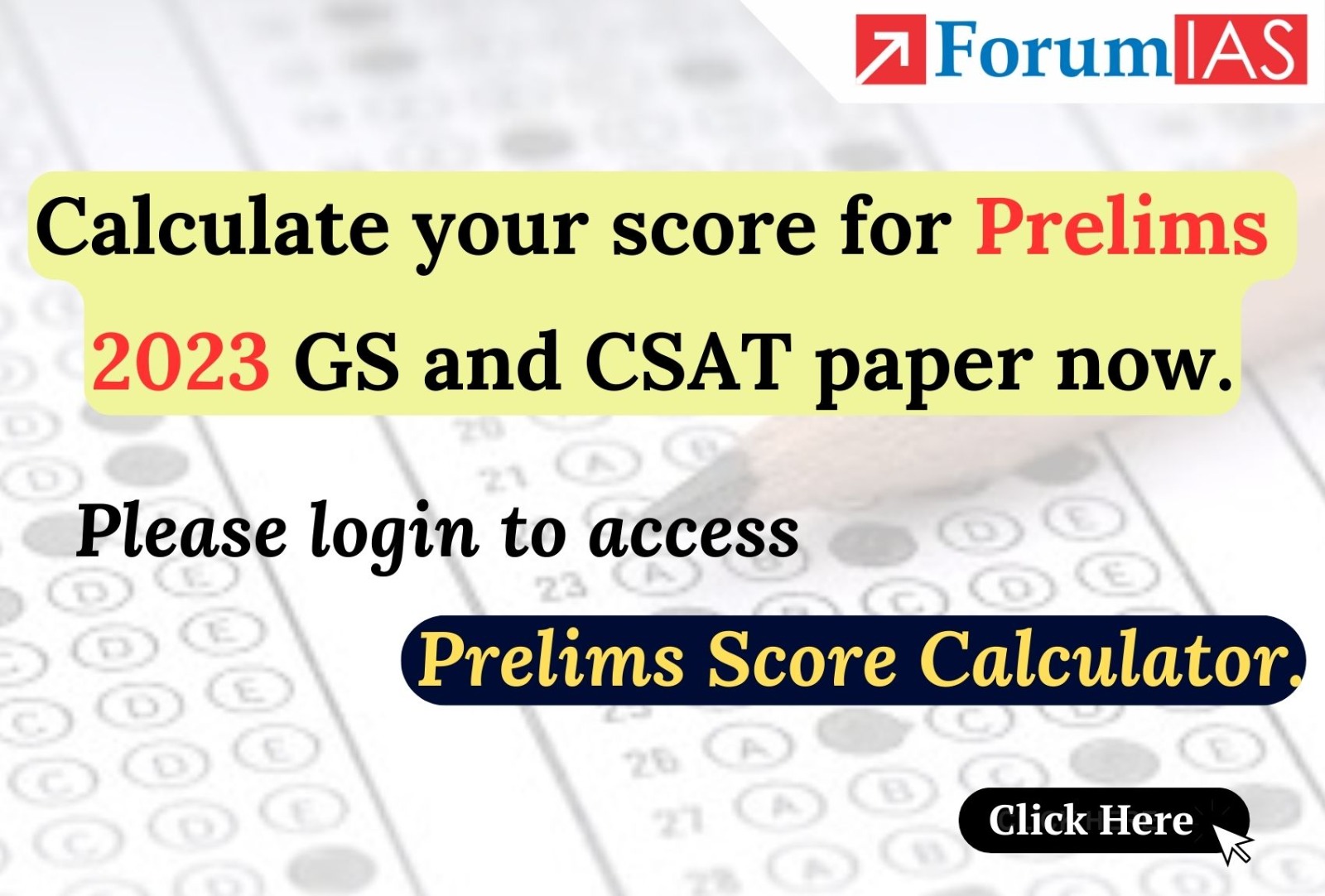Important Update : LIVE Session for SFG 2021 - Level 1 General Discussion and Way Forward - 19th January 2021 at 4:00 PM. (Click Here)
To check the instructions on how to write SFG 2021 - Test 1 :
Important Dates:
Date of Entrance Test 2 - 3rd January 2021 (10:00 AM to 11:00 AM)
End Date Registration for Entrance Test 2 – 2nd January 2021 | 5 PM
Please click on the link for instructions regarding attempting the Entrance test.
Result of Entrance Test 2 –4th January 2021
Commencement Date of SFG Level 1 – 7th January 2021
Syllabus of SFG Entrance Test - Candidates can expect 30 questions equally distributed across History, Polity, Economy, Environment and Geography. Further 15 questions will from Current Affairs of October, November and December months and 5 questions from CSAT.
SFG Level 1 Calendar: https://go.forumias.com/sfg21-calender
SFG – How it works
- Select Focus Group (SFG) is a small group of students who are selected by ForumIAS every year for coaching them to clear the UPSC Prelims Examination. Every single candidate selected and retained consistently in the group with Top ranks has cleared the Prelims examination in the past.
- 100 Students will be selected for the Select Focus Group, through the SFG Entrance Test, who will be required to report at 7 AM every day 6 days a week to write an hour-long test based on a pre-planned syllabus, followed by a discussion on the same.
- Candidates who are unable to make it to the SFG, will be maintained in a Reserve List, who can also write the tests. Candidates who couldn't clear the cutoff and are unable to make it into both SFG and RLG can register for the 2nd Entrance Test
- Tests are conducted daily and results are provided within 8 hours of test with Name and Rank list for candidates and parents to evaluate their daily performance. On the basis of rankles, about 50% of bottom performing students from SFG are migrated to the reserve list on a weekly basis, and an equal number of students from reserve list (RLG) are moved into SFG.
- The decision of the management in this regard is final and not subject to dispute. Please note that this migration is done not keeping in mind the overall merit list but moving away bottom 50% from SFG and picking up an equal number of people from RLG.
- Thus those who may be getting more than RLG students, but are bottom 50 in SFG will be moved to RLG.
- Every month, the bottom 20% or so non-performing students are eliminated from the program to maintain the quality of competition.
- All candidates writing the CSE 2021 are eligible to apply for the entrance test.
This year we introduce some changes as to how we conduct the SFG exam. Please note that changes that we bring are always in response to the examination pattern, the student feedback and our own learning with respect to how to best enable a serious candidate to clear the exam
Covid 19 Update:Keeping in mind the Covid situation, SFG – 1 entrance Test and the SFG program will be conducted in the online mode only for the year 2021. SFG – Level 2 may be conducted offline as per government guidelines and this decision will be taken at a later date.
This year SFG will be conducted in two levels as below:
SFG Level 1 (Foundation)
The SFG Level 1 is for beginners, freshers, first-timers, or simply those who have not cleared the Prelims examination ever before. The objective of the SFG Level 1 Program is three things
- Students know the basic books and basic concepts back and forth
- Students complete coverage of the syllabus through self-study
- Students are thorough with previous years papers
- Students develop the discipline and time management skills that are needed to clear the exam
The SFG Level 1 Tests will have book based / text-based / notes-based tests. By the end of SFG Level 1, you can expect that your coverage of the syllabus is complete, and you have done previous years questions well.
SFG Level 2 (Advanced)
SFG Level 2 is for people who have completed the reading and revision of the basic books and are now ready to take on the exam. The objective of the SFG Level 2 is as below
- Developing problem-solving skills for solving analytical, conceptual and thought based questions.
- Developing skills to solve questions based on the application of the reading that they have done for Level 1
- Mastering the art of handling questions from unknown areas and applying concepts from their wider reading which is relevant for the Civil Services Prelims Examination.
- Developing time management skills, and being through with the syllabus
- Providing a reliable, time-bound framework for revision just before the examination.
Current Affairs:
SFG Level 1 will provide coverage of current affairs from January 2020 to November 2020.
SFG Level 2 will have complete current affairs relevant for the Prelims examination 2021 integrated into the course.
CSAT:
CSAT tests will be integrated with SFG Level 2. There will be no CSAT tests in SFG level 1.
Application Procedure
- Admission to the SFG and RLG are based on the rank of the candidate in the merit list of the SFG Entrance Test. Students can apply for the program by registering for the Entrance Test by paying a fee of Rs. 500+ GST. Candidates can register by visitinghttp://academy.forumias.com
- The candidate must appear for the entrance test on the designated date and time, subsequent to which he/she will be admitted to the Select Group or the Reserve List.
- The candidate must pay the monthly fee as per the group he/she is allocated.
Note: Admissions to the SFG / RLG Group will only be on the basis of merit position of the candidate in the entrance test. Entrance Test will be held on 23rd December 2020. Candidates must register for the SFG Entrance Test by visiting the website http://academy.forumias.com before12 PM, December 22nd.
No admission will be granted to the candidate without appearing for the Entrance Test.
Fee Structure and Details:
- The course duration is of about two months and fees is charged on a monthly basis. Fees for the full duration of the program cannot be paid at one go.
For students selected in SFG- Rs. 1300 + GST (18%) per month. For Payment,Click Here.
For students selected in RLG- Rs. 1900 + GST (18%) per month. For Payment,Click Here.
- Fees are to be paid once the candidate is selected for the program. A fee of Rs. 118 is to be paid additionally for the I-Card by all students.
Wishing you Success,
Always
ForumIAS Academy
Someone please explain in layman's term how imports/ exports affect the Rupee exchange rate vis-a-vis Dollar.
My reasoning is : more imports ->more dollar going out of country in order to pay for those imports->leaves more Rupee in domestic market as compared to dollars ->leads to weakening of Rupee.
Is this line of thought correct?
Someone please explain in layman's term how imports/ exports affect the Rupee exchange rate vis-a-vis Dollar.
My reasoning is : more imports ->more dollar going out of country in order to pay for those imports->leaves more Rupee in domestic market as compared to dollars ->leads to weakening of Rupee.
Is this line of thought correct?
Similarly, more the export, more accumulation of dollars, leading to rupee value coming down as the supply of dollars has increased (appreciation or strengthening)
Why :
any transaction may it be import or export needs dollars to transact.
Exchange rate :
Means how much one country's currency needed against US Dollar to buy the same product.
Lehman:
If you are exporting enough ... than you are earning in terms of dollar (there are other ways to get dollar in one's economy e.g. Remittances)... that is you have now dollars for your import too...
If you are importing more... than you will loose on those dollars you have earned .... in this case you will be dependent on other financial source to get those dollars but not without interest rate... this interest rate is the main cause of the problem here ...
Now suppose you were spending 100 dollars for a mobile... and you had 10000 rs .....and 1 dollar =60 rs
Due to interest you will end up loosing more money (just like flipcart installment buying)....maybe 130 dollars... SO this interest amount of 30 dollars is an addition burden. If you had dollars you could have bought the mobile for 100*60 = 6000 rs .... but now you are paying 130*60= 7800 rs ....
So you will be able to buy less product...
And this will depreciate your Pocket value or if you are country than your exchanges will suffer...ultimately depreciating your currency.
Hi @root , can you clarify that if we buy this test series : https://sgp1.digitaloceanspaces.com/forumias/noticeboard/wp-content/uploads/2020/07/04225602/PTS-12th-July-2020-Update.pdf
will we get access to simulator test 1-8 also ?
Thanks
@jack_Sparrow Q 44 only 2nd statement is visible. Kindly help.@forumiasacademy
@Thinker @jack_Sparrow Q44 only showed statement 2 please consider this while creating rank list.
@Thinker @jack_Sparrow Q44 only showed statement 2 please consider this while creating rank list.
Yes same issue
@forumiasacademy @jack_Sparrow
Correct Answer : c
Your Answer : a
Consider the following statements:
1. Repatriation of funds is allowed from Foreign Currency Non-Resident (Bank) Accounts.
2. The rate of interest applicable on the Foreign Currency Non-Resident (Bank) Account & Non-Resident External Account is decided by the EXIM.
Which of the statements given above is/are correct?
Explanation
Exp) Statement 1 is correct - Repatriation of funds is allowed from both Foreign Currency Non-Resident (Bank) Account & Non-Resident External Account. Whereas for Non-Resident Ordinary Rupee Account the principle is non-repatriable but the interest and current income is repatriable. Hence all the three accounts are included in counting India's external debt.
Statement 2 is correct - The rate of interest applicable on the Foreign Currency Non-Resident (Bank) Account & Non-Resident External Account is decided by the RBI (and not EXIM)
Correct Answer : b
Question: 8
Consider the following statements regarding Treasury Bills (TB):
1. They are long-term money market instruments.
2. They are used by the Central Government to fulfill its liquidity requirement.
3. They can be used by banks to fulfill their CRR and SLR requirements.
Which of the statements given above is/are correct?
Are payment banks and SFBs included as Scheduled Commercial Banks ?
@Steph_Curry yes.


 Ramesh Singh,-Economics
Ramesh Singh,-Economics



